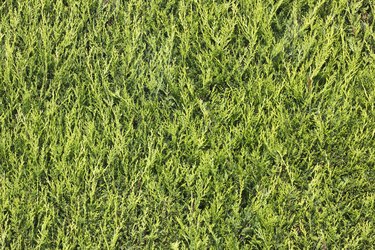
Plant a Leyland cypress (× Cuprocyparis leylandii) in well-drained, moist, rich soil in a full-sun site to get the best from this fast-growing, versatile evergreen tree. Leyland cypress is hardy in U.S. Department of Agriculture plant hardiness zones 6 through 10 and grows in most soils. Useful as a privacy hedge or specimen tree, in its preferred conditions it grows up to 100 feet tall and 10 to 15 feet wide.
Planting Time
Video of the Day
Planting times for Leyland cypress vary according to how the tree was prepared at the nursery. Leyland cypress are grown as bare root stock, balled and burlapped trees and containerized trees. Plant bare root Leyland cypress in winter when the tree isn't growing, and because Leyland cypress roots are brittle, take care not to damage them. Balled and burlapped tree roots are wrapped in the coarse fabric and twine or other permeable coverings. Balled and burlapped trees, as well as containerized trees, can be planted any time but early spring is the best time, allowing the tree a growing season to recover before winter sets in. Gently remove a containerized tree from its container and check that the roots fill the pot. If the soil falls away from the roots, treat the Leyland cypress as a bare root tree.
Video of the Day
Tree Preparation
Careful preparation helps ensure Leyland cypress grows well after planting. Gently push a thin screwdriver into the top of the Leyland cypress root ball to find where roots thicker than 1/2 inch in diameter appear. These structural roots should be at the top of the root ball. If structural roots are one to two inches below the root ball surface, remove the soil above them and plant the tree so these roots lie just above the surface. Leyland cypress planted with structural roots below the surface doesn't grow well and sometimes dies. Soak bare root Leyland cypress in water for three to four hours before planting.
Tree Planting
A wide, shallow planting site helps Leyland cypress recover quickly from planting. Plant trees 10 to 15 feet away from walls, fences or surrounding vegetation, and space them out 5 to 10 feet if planting a hedge. Dig a hole 1 inch less deep than the root ball if the tree trunk diameter is 1 inch or 2 inches less deep than the root ball if the trunk diameter is 2 to 4 inches. Dig the hole twice as wide as the root ball. Place a bare root or balled and burlapped tree in the center of the hole; remove a containerized tree from its container and place it in the hole. Spread out the roots of a bare root tree evenly in all directions; remove the top two-thirds of the covering of a balled and burlapped tree. Scoop soil from the edges of the hole to fill in gaps between bare roots and hold the tree upright, creating sloping edges to the hole. Don't cover structural roots with soil. Fill in the rest of the hole with dug soil, and water the soil to settle it.
After Care
Organic mulch and regular watering help Leyland cypress thrive. Spread a 3-inch layer of organic mulch, such as garden compost, leaf mold or shredded bark, over the planting hole but avoid the structural roots. Young Leyland cypress trees require a constantly moist soil for the first two or three years. Water newly planted trees whenever the soil is dry 1 inch deep, which may be as often as three times a week or more in dry periods. Don't overwater so that the soil is sodden. Leyland cypress tolerates drought when established, but in some areas drought stress can make trees vulnerable to a canker disease that causes oozing cracks in the bark, purple and brown patches, and dying shoots.
- Missouri Botanical Garden: X Cuprocyparis Leylandii
- North Carolina State University Cooperative Extension: Leyland Cypress
- University of Florida IFAS Extension: X Cupressocyparis Leylandii -- Leyland Cypress
- Colorado State University Extension: Tree Planting Steps
- University of Missouri Extension: How to Plant a Tree
- Colorado State University Extension: Care of Recently Planted Trees